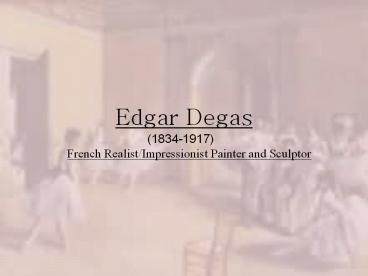Edgar Degas - PowerPoint PPT Presentation
Title:
Edgar Degas
Description:
Edgar Degas (1834-1917) French Realist/Impressionist Painter and Sculptor Edgar Degas Art The art of Degas reflects a concern for the psychology of movement and ... – PowerPoint PPT presentation
Number of Views:3243
Avg rating:3.0/5.0
Title: Edgar Degas
1
Edgar Degas
(1834-1917)
- French Realist/Impressionist Painter and Sculptor
2
Edgar Degas was born in Paris on July 19, 1834.
He was born to a family of aristocrats, and like
every privileged child at the time, he was
exposed to the finer things in life. Ballet,
opera, art, music were all part of his staple.
His father, a banker, had aspirations of seeing
Edgar as a lawyer. Degas even enrolled in law
school for a brief period after secondary school,
but fate had things planned. Edgars idol was
the painter Jean Auguste Ingres, whose example
pointed him in the direction of a classical
draftsmanship, stressing balance and clarity of
outline. After beginning his artistic studies
with Louis Lamothes, a pupil of Ingres, he
started classes at the Ecole des Beaux Arts but
left in 1854 and went to Italy. He stayed there
for 5 years, studying Italian art, especially
Renaissance works.
Name Hilaire-Germain-Edgar Degas Born Paris,
France19 July 1834Died Paris, France27
September 1917
3
Edgar Degas Art
- The art of Degas reflects a concern for the
psychology of movement and expression and the
harmony of line and continuity of contour. These
characteristics set Degas apart from the other
impressionist painters.Or it in other words,
Degass view of impressionism was different from
other painters of his era. He was not fascinated
by nature and the outdoors, he would much rather
observe the human condition and with his brush
strokes, incorporate its intricacies into every
one of his paintings. He confined himself to
working in studios, often staying indoors for
days at a stretch. Many critics think twice
before classifying Degas as an impressionist.
Indeed, he himself called himself a realist with
contemporary subjects. It would be fair to say
that in Degass evolution that was seen an
emergence of a new, alternative impressionism. - Degas was acknowledged as the master of
drawing the human figure in motion. Degas worked
in many mediums, preferring pastel to all others.
He is perhaps best known for his paintings,
drawings, and bronzes of ballerinas and of race
horses.
4
Edgar Degas Art
- Degas painted portraits of his family and friends
(when back in Paris ,1859) and a number of
historical subjects, in which he combined
classical and romantic styles. In Paris, Degas
came to know Edouard Manet,and in the late 1860s
he turned to contemporary themes, painting both
theatrical scenes and portraits with a strong
emphasis on the social and intellectual
implications of props and setting. - In the early 1870s the female ballet dancer
became his favorite theme. He sketched from a
live model in his studio and combined poses into
groupings that depicted rehearsal and performance
scenes in which dancers on stage, entering the
stage, and resting or waiting to perform are
shown simultaneously and in counterpoint, often
from an oblique angle of vision.
5
On a visit in 1872 to Louisiana, where he had
relatives in the cotton business, he painted The
Cotton Exchange at New Orleans (finished 1873
Musée Municipal, Pau, France), his only picture
to be acquired by a museum in his lifetime. Other
subjects from this period include the racetrack,
the beach, and cafe interiors.
Edgar Degas Art
The Cotton Exchange in New Orleans1873Oil on
canvas
6
Works of Art
- Degas spent many years of his career
painting scenes from history. Even though the
subjects seemed inadequate to him, they were some
of his most popular paintings. An example of his
popularity was his painting based on biblical
history, 'Daughter of Jephthah, which was based
on an incident from the Old Testament. The
painting garnered rave reviews, and to date is
regarded as one of Degas's finest.
7
Works of Art
- An example of his portraiture is 'The
Bellelli Family which he painted in 1860.
Degas's early years as a classical draftsman gave
him the ability to paint the human form with
effortless ease.
8
Works of Art
- Degas's obsession with movement manifest
itself in his various paintings of horses. Race
Horses, arguably the most famous fruit of this
equestrian obsession, now rests in the
Philadelphia Art Museum.
9
Works of Art
- His most famous subjects are undoubtedly
the young ballerinas that caught his artistic eye
in the later stages of his career.One of his most
famous paintings is Dance class at the Opera
which he painted in 1872. The painting, which now
hangs at the Mus?e d'Orsay in Paris is a perfect
example of Degass fluid style.
10
Works of Art
- Degass apparent schizophrenic opinion of
women has puzzled art critics to this day. He was
a self-acknowledged misogynist and yet the female
form was his favorite subject. He was able to
bring out from within his female subjects a
quality that the lesser, more mortal admirer can
only marvel at. Les repasseuses , or Woman
Ironing is one of Degass most famous feminine
subjects. It was painted in 1888, and rests among
many other Degas masterpieces at the Musee
d'Orsay, Paris.































